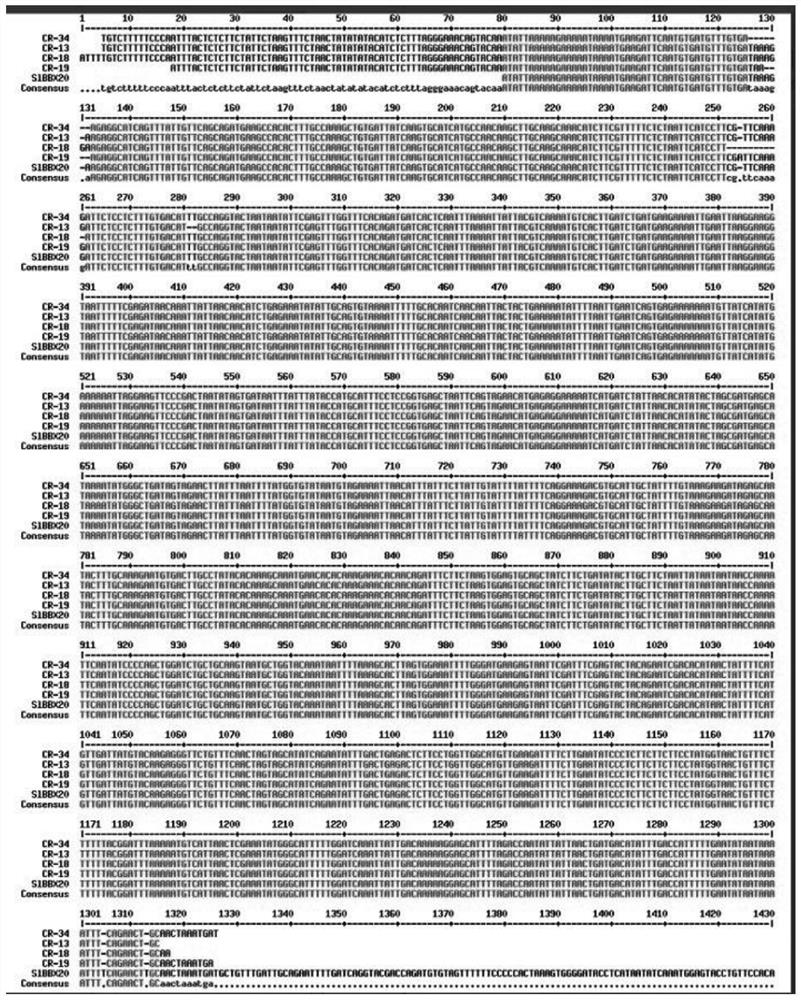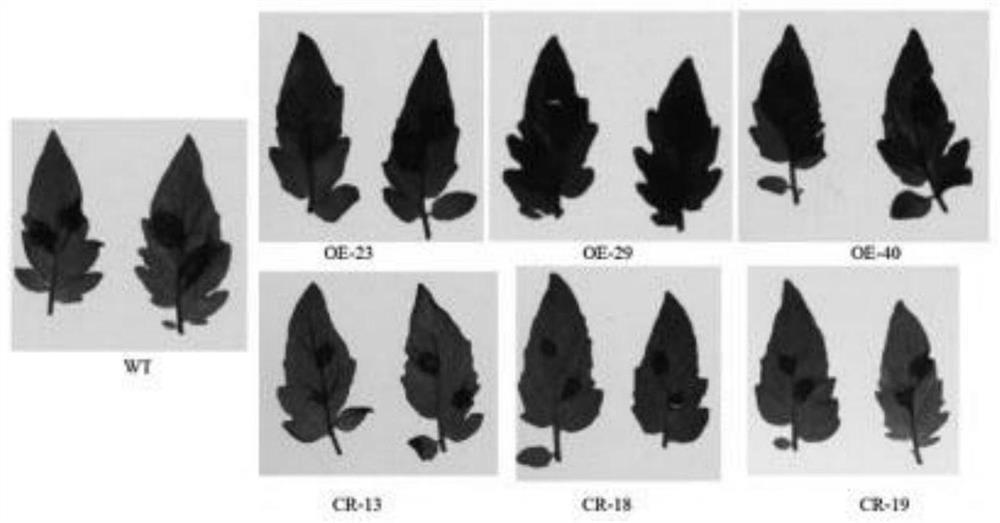Application of slbbx20 Gene in Regulating Tomato Botrytis Botrytis Resistance
A technology for tomato gray mold and gray mold, which is applied in the field of genetic engineering, can solve the problems of affecting food quality, environmental hazards, and the effect is not very good, and achieves the improvement of gray mold resistance and reduction of gray mold resistance. Effect
- Summary
- Abstract
- Description
- Claims
- Application Information
AI Technical Summary
Problems solved by technology
Method used
Image
Examples
Embodiment 1
[0041] Inducible expression profile of SlBBX20 gene in Botrytis cinerea resistant materials
[0042] Botrytis resistant material TS179 (variety selected from TGRC, American Tomato Genetic Resources Center) and botrytis susceptible material TS100 (variety selected from TGRC, American Tomato Genetic Resources Center) were sown, and the seedlings grown for 4 weeks were inoculated with Botrytis cinerea experiment. Take pictures to observe the disease-resistant material TS179 (see Figure 5 ) and susceptible material TS100 (see Image 6 ) incidence of Botrytis cinerea 72h inoculation. In the resistant material TS179, the lesions were smaller, but the lesions spread greatly after the susceptible material TS100 was inoculated with Botrytis cinerea for 72 hours. Samples were taken at different time points (0h, 24h, 48h and 72h) of inoculation of Botrytis cinerea, RNA was extracted, reverse transcribed into cDNA, and real-time quantitative PCR was performed to detect the presence of...
Embodiment 2
[0050] Preparation of SlBBX20 gene knockout vector
[0051] The DNA sequence of the SlBBX20 gene was searched on the SGN (https: / / www.sgn.cornell.edu / search / locus) website, and the DNA sequence of the gene was entered into the CRISPR design website (http: / / crispr.hzau.edu .cn / cgi-bin / CRISPR2 / CRISPR), select two suitable targets according to the off-target rate, etc.: including the first target fragment of the SlBBX20 gene and the second target fragment of the SlBBX20 gene, the first target fragment of the SlBBX20 gene The sequence is shown in SEQ ID NO.3, and the sequence of the second target fragment of the SlBBX20 gene is shown in SEQ ID NO.4.
[0052] Gene synthesis contains primers of two targets, the primer sequence of the first target fragment of the SlBBX20 gene is as shown in SEQ ID NO.5, and the primer sequence of the second target fragment of the SlBBX20 gene is as shown in SEQ ID NO.6 .
[0053] Use synthetic primers containing the target sequence, with the pCBC_D...
Embodiment 3
[0061] Vector preparation with ORF gene fragment of SlBBX20
[0062] The total RNA in tomato was extracted with Trizol (Vazyme, China) reagent, and then the cDNA of tomato gene (sequence shown in SEQ ID NO. Primer, the front primer sequence is shown in SEQ ID NO.7, the rear primer sequence is shown in SEQ ID NO.8, and the ORF (open reading frame) of the SlBBX20 gene is obtained by PCR amplification, and the sequence is shown in SEQ ID NO.2 , detected by 1.0% agarose gel, and recovered the target fragment with a recovery kit (OMEGA, USA).
[0063] The reverse transcription system is as follows:
(1)
[0064] RNase free ddH 2 O to 16μL
[0065] 4*gDNAwiperMix 4μL
[0066] Template RNA 1μg
[0067] Gently mix with a pipette, 42 °C for 2 min.
(2)
[0068] Directly add 4 μL of 5*HiScript II Qrt SuperMix II to the reaction tube in the first step, mix by gently pipetting, 50°C for 15min, 85°C for 5s. cDNA can be obtained after this procedure, and the product can be directly...
PUM
 Login to View More
Login to View More Abstract
Description
Claims
Application Information
 Login to View More
Login to View More - R&D
- Intellectual Property
- Life Sciences
- Materials
- Tech Scout
- Unparalleled Data Quality
- Higher Quality Content
- 60% Fewer Hallucinations
Browse by: Latest US Patents, China's latest patents, Technical Efficacy Thesaurus, Application Domain, Technology Topic, Popular Technical Reports.
© 2025 PatSnap. All rights reserved.Legal|Privacy policy|Modern Slavery Act Transparency Statement|Sitemap|About US| Contact US: help@patsnap.com



